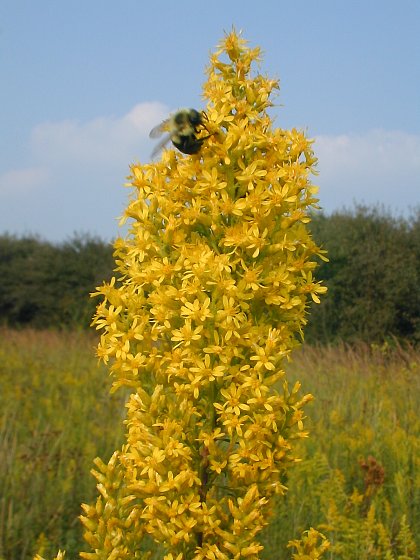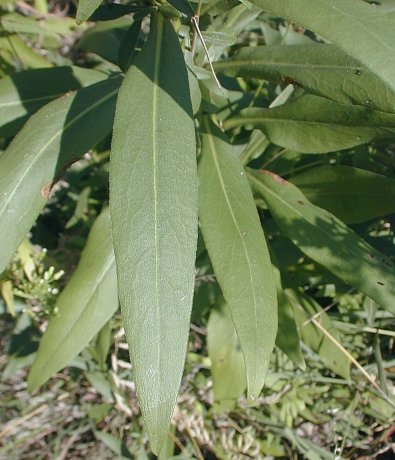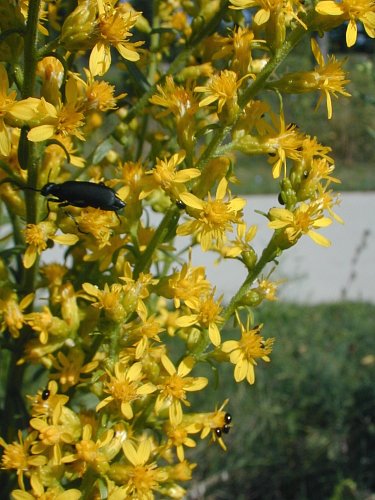Description: This perennial plant is usually unbranched and up to 4' tall. The smooth central stem can be green or reddish. The alternate leaves are up to 6" long and 1½" wide, becoming slightly smaller as they ascend up the stem. They are narrowly lanceolate or oblong-elliptic, smooth along their margins, and largely devoid of hairs. In the upper half of the plant, there are often small leaves that develop from the upper axils of the primary leaves; they have a wing-like appearance. The showy inflorescence is up to 1' long, consisting of an erect panicle of small yellow compound flowers. The flowering stems don't curve outward and downward like many other goldenrods, but are held erect or curve upward. Each compound flower is about ¼" across, consisting of 4-10 ray florets surrounding the disk florets. The spacing of the ray florets tends to be irregular, and they may not open at the same time. These flowers occasionally have a mild fragrance. The blooming period occurs during late summer or early fall, and lasts about a month. Later, the achenes develop small tufts of hairs, and are dispersed by the wind. The root system is fibrous and rhizomatous, occasionally forming vegetative offsets. In older mature plants, a woody caudex develops.

Cultivation:
The
preference is full or partial sun, and slightly moist to slight dry
conditions. The soil can contain significant amounts of loam, sand, or
rocky material. Occasionally, the leaves succumb to powdery mildew and
other kinds of foliar disease, particularly after the blooming period
is over in the fall. This plant is easy to grow, but can topple over if
it is spoiled by excessive moisture or fertilizer.
Habitat & Range:
The native Showy Goldenrod occurs occasionally in the northern half of
Illinois,
and is uncommon or absent in the southern half (see Distribution
Map). Habitats include mesic to slightly dry black soil
prairies, sand prairies, openings in rocky upland forests, Black Oak
savannas, thickets, woodland borders, and abandoned fields.

Faunal Associations: The flowers attract honeybees, bumblebees, ants, beetles, and the occasional moth or butterfly. Among the beetles, are such visitors as Chauliognathus pennsylvanicus (Goldenrod Soldier Beetle) and Epicauta pensylvanica (Black Blister Beetle). These insects seek nectar primarily. The caterpillars of many moths feed on various parts of this goldenrod and others (see Moth Table). Other insect feeders include various leafhoppers, lace bugs, plant bugs, and beetles. To a limited extent, the seeds are eaten by the Eastern Goldfinch and the Greater Prairie Chicken. Mammalian herbivores occasionally eat the leaves, stems, and flowers, including deer, rabbits, groundhogs, and livestock. When this plant is infected by a fungus (Coleosporium sp.), it can cause sickness and death in cattle and horses. Like other goldenrods, it may contain a hemolytic agent that is mildly poisonous to some herbivores.

Photographic
Location:
The photographs were taken at Meadowbrook Park in Urbana, Illinois.
Comments:
As the common and scientific names imply, this plant is very showy
while in bloom. Showy Goldenrod can be distinguished from other
goldenrods that occur in Illinois prairies by the following
characteristics, when they are considered together: 1) the flowering
stems of the inflorescence are held erect or curve upward, rather than
outward and downward; 2) both the stems and leaves are hairless, or
nearly so; 3) there are often smaller wing-like leaves in the upper
axils of
the primary leaves, particularly in the upper half of the central stem,
and 4) the leaves lack teeth.